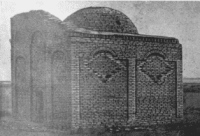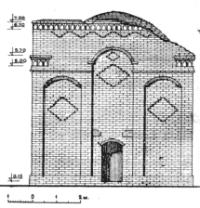You are here
Mausoleum of Kara-Kul.


Monuments in steppes of Ulytau.
“The use of lancet three-center arches is noted during the heyday of architectural and construction activities in certain regions of Kazakhstan, and semicircular, as a simpler construction, in later structures.”
Georgy Gerasimovich Gerasimov.
Mausoleums in Ulytau on Kara-Kengir river.
25 kilometers from the city of Novy Dzhezkazgan, not far from the Kara-Kengir River, on the right bank, stands the Kara-Kul mausoleum. By its appearance and condition, one can determine that it was built recently. Indeed, the mausoleum was erected in 1904 - 1905.
The architectural forms of the monument clearly reflected the new that appeared in the building art of that time. The stylistic features of Kara-Kul and compositional techniques indicate the creative processing of the heritage of national architecture and forms of Russian architecture of later times.
Here there are pilasters in the form of lisen, various fastenings, arched arches and vaults, diamond-shaped calculations on the surface of the walls, made by “embedding” them into the masonry itself, etc., which are not characteristic of the methods of the former national architecture.
This suggests that construction in cities by the beginning of the 20th century had a great influence on local traditions and production techniques and played a significant role in the rise of architecture. The object we are considering is a vivid proof.
By tradition, the building is a single-chamber, centric-domed structure, oriented to the southwest. The builders, paying tribute to the past, took into account the visibility of the building from all sides, and therefore all its facades, especially the main one, are designed with an accentuated splendor.
In this regard, the success of the builders is obvious. On the mausoleum, a prefabricated cornice made of burnt ceramic tiles is in harmony with the relief image of arches. He is light and fluffy. The tiles, like some of the bricks used in the laying of rhombuses, have multi-colored tones, made, apparently, in the form of a fresco on a damp surface before firing; they are now very faded.
This cornice encircles the building from three sides, and on the front facade - on the parapet, U-shaped in plan, it is located much higher than on the side ones. Deficiencies in fastening tiles to brick walls led to their premature loss and destruction.
According to the composition, the main facade has a triaxial articulation with three shallow niches, completed with arches (semicircular in the middle and arched in the outer ones). The middle niche is larger in height and width, because along its axis, which is the main axis of the building, there is an entrance opening 0.87 x 1.98 m in size with an arched lintel.
Below the cornice, on the smooth surface of the walls of the main facade, in the masonry, an imitation of the "cogwheels" of the fortress walls was made, in the niches - diamond-shaped calculations, two rafters on the sides of the entrance opening and a belt of half-cut bricks under the prefabricated cornice.
On the side facades, the same design techniques as on the main one. In plan, the mausoleum is a square with sides equal to 4.88 x 4.79 meters on the inside and 6.65 x 6.97 meters on the outside. The total height of the mausoleum is 7.35 meters.
Some difference in the longitudinal sides occurred due to an increase in the thickness of the front wall. The same traditional method as on other mausoleums was used in the design techniques for transforming the plan from a square to an octagon, and then to a circle.
In the dome, in the direction of the main axes of the building, four small holes were left. The interior of the room makes a good impression, because the lancet arches covering the niches and the sails in the corners are made in good proportions.
It creates the impression of large volume and monumentality. To the right of the entrance, in the thickness of the front and side walls, there is a small-sized staircase leading up to the dome platform. This area around the dome drum is protected from the outside by a low parapet.
The walls of the building are made of burnt red bricks on clay mortar. The plaster is missing. The floor of the mausoleum, laid with bricks in one row, “flat”, is well preserved. No structures in the form of a sagan were erected over the grave of the deceased.
The building has a shallow foundation of stone and brickwork and above ground - a brick base 40 cm high, which contributed to the preservation of the building. The general condition of the building is satisfactory.
Authority and photos by
Georgy Gerasimovich Gerasimov. "Monuments of architecture of the Kara-Kengir river valley in Central Kazakhstan". Publishing house of the Academy of Sciences of the Kazakh SSR. Alma-Ata. 1957







